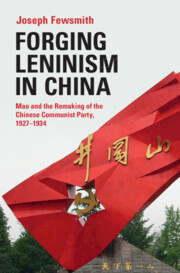Book contents
- Forging Leninism in China
- Forging Leninism in China
- Copyright page
- Dedication
- Contents
- Figures
- Maps
- Acknowledgments
- Introduction
- 1 Disaster and Local Rebellion
- 2 The Donggu Revolutionary Base Area
- 3 A Different Approach to Revolution
- 4 Mao versus Local Forces
- 5 The Logic of Sufan
- Conclusion
- Glossary
- Bibliography
- Index
5 - The Logic of Sufan
Published online by Cambridge University Press: 03 February 2022
- Forging Leninism in China
- Forging Leninism in China
- Copyright page
- Dedication
- Contents
- Figures
- Maps
- Acknowledgments
- Introduction
- 1 Disaster and Local Rebellion
- 2 The Donggu Revolutionary Base Area
- 3 A Different Approach to Revolution
- 4 Mao versus Local Forces
- 5 The Logic of Sufan
- Conclusion
- Glossary
- Bibliography
- Index
Summary
Chapter Five discusses two things. First, it looks at the aftermath of the Futian Rebellion and at Xiang Ying’s efforts to calm things down. Xiang’s efforts were soon reversed by the arrival of the “three person group,” which implemented the radical new line coming out of the Comintern. Zhou Enlai would later try to control the sufan movement, but new leadership (Bo Gu) and the pressing need for soldiers and money would reignite efforts to suppress so-called counterrevolutionaries. Second, the chapter looks briefly at the Eyuwan Revolutionary Base Area, north of the Yangzi river, to show that the same logic of sufan applied there as well.
Keywords
Information
- Type
- Chapter
- Information
- Forging Leninism in ChinaMao and the Remaking of the Chinese Communist Party, 1927–1934, pp. 140 - 163Publisher: Cambridge University PressPrint publication year: 2022
